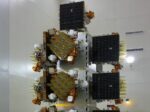At DSEI 2025 in London, Belgian defense integrator John Cockerill Defense (JCD) showcased an expanded line of modular turrets and announced a new collaboration with French vehicle manufacturer ARQUUS. The partnership aims to integrate advanced counter-unmanned aerial system (C-UAS) capabilities into next-generation land platforms—an increasingly critical requirement in modern battlefield environments saturated with small drones.
Modular Turret Expansion Targets Multi-Mission Flexibility
John Cockerill Defense presented several new variants of its proven modular turret architecture at DSEI 2025. These included enhanced versions of the CPWS Gen.2 (Cockerill Protected Weapon Station) and the larger C3105/3105HP turrets designed for integration on medium armored vehicles. The upgraded turrets feature improved sensor fusion packages, increased protection levels (up to STANAG Level 4), and support for a wider array of weapon systems including automatic cannons up to 105 mm caliber.
The CPWS Gen.2 is particularly optimized for lighter platforms such as 4×4 or 6×6 armored vehicles. It supports remote operation from within the vehicle hull and can be fitted with a range of armaments from 25 mm to 30 mm autocannons, coaxial machine guns, and anti-tank guided missile (ATGM) launchers. The turret’s low silhouette and reduced weight profile make it suitable for rapid deployment forces and reconnaissance units.
Meanwhile, the heavier C3105 series offers direct fire support capabilities with its ability to mount a high-pressure NATO-standard 105 mm gun. This allows wheeled or tracked vehicles equipped with the turret to engage both armored threats and fortified positions at extended ranges—filling the gap between infantry fighting vehicles (IFVs) and main battle tanks (MBTs).
ARQUUS Partnership Focuses on Counter-Drone Integration
The headline announcement at DSEI was JCD’s strategic partnership with French military mobility specialist ARQUUS. The two companies are co-developing an integrated counter-UAS solution that merges JCD’s fire control systems and turret architecture with ARQUUS’ vehicle platforms such as the SCARABÉE hybrid-electric light armored vehicle.
This integration will allow future vehicles to detect, track, and neutralize Class I UAVs (<25 kg) through a layered approach combining soft-kill electronic warfare methods (e.g., RF jamming) with hard-kill options such as airburst munitions or directed-energy weapons mounted on JCD turrets.
According to representatives from both firms at DSEI, initial prototypes are expected by mid-2026. The system is being designed for interoperability within NATO command-and-control frameworks using open architecture standards like STANAG 4586 for UxV control interfaces.
Operational Drivers Behind Counter-UAS Emphasis
The decision by JCD and ARQUUS to prioritize counter-drone capabilities reflects shifting battlefield dynamics observed in recent conflicts—including Ukraine—where commercial quadcopters have been weaponized for ISR roles or loitering munition attacks.
“The proliferation of low-cost drones has dramatically altered force protection requirements,” said a JCD program engineer during the show. “Our customers are demanding integrated solutions that can respond autonomously in seconds—not minutes—to drone threats.”
This trend is also driving demand for AI-enhanced target recognition software embedded within fire control systems. While not confirmed by either company at DSEI, industry sources suggest that future iterations of JCD’s turret suite may incorporate machine vision modules trained on drone signatures using synthetic data sets—a capability already under development by several European defense AI labs.
Platform Compatibility Across NATO Fleets
A key selling point of both JCD’s turrets and their joint solution with ARQUUS is platform agnosticism. The CPWS Gen.2 can be retrofitted onto legacy wheeled platforms like the Piranha III or VAB Mk3 while also supporting new-generation vehicles such as Patria AMV XP or Boxer MRAV variants.
- C3105/C3105HP: Compatible with tracked IFVs like CV90 or ASCOD; wheeled platforms like Centauro II
- CPWS Gen.2: Designed for light armor including JLTV-class vehicles; adaptable via standard ring mounts
- C-UAS module: Designed as an add-on kit compatible across multiple vehicle architectures via NATO-standard data buses
This cross-platform compatibility is crucial given NATO’s increasingly expeditionary posture across Eastern Europe, Africa, and Indo-Pacific theaters where logistics chains must accommodate diverse fleets under common operational doctrines.
Industrial Implications and Export Potential
The collaboration also positions both companies favorably in upcoming procurement competitions across Europe and MENA regions where modernization programs are emphasizing modularity and survivability against drone swarms.
Belgium’s own CAMO program—which includes modernization of its Piranha fleet—could serve as an early adopter platform for these integrated systems. Meanwhile France’s SCORPION program may benefit from lessons learned through this partnership when evaluating future upgrades to Griffon or Jaguar variants.
JCD has previously exported its turret systems to Indonesia (Harimau medium tank), Nigeria (Otokar Cobra II), Saudi Arabia (LAV derivatives), among others—demonstrating global interest in adaptable firepower solutions that can scale across mission profiles from peacekeeping to peer conflict scenarios.
Outlook: Toward Autonomous Engagement Capabilities?
The long-term trajectory hinted at during DSEI suggests that John Cockerill Defense may pursue further automation of its turret line—including semi-autonomous engagement modes governed by human-in-the-loop protocols compliant with emerging EU/NATO ethical guidelines on lethal autonomous weapon systems (LAWS).
If realized, this would position JCD among a small cohort of Western OEMs offering AI-assisted lethality management suites—a capability currently dominated by Israeli firms like Elbit Systems or Rafael Advanced Defense Systems.









